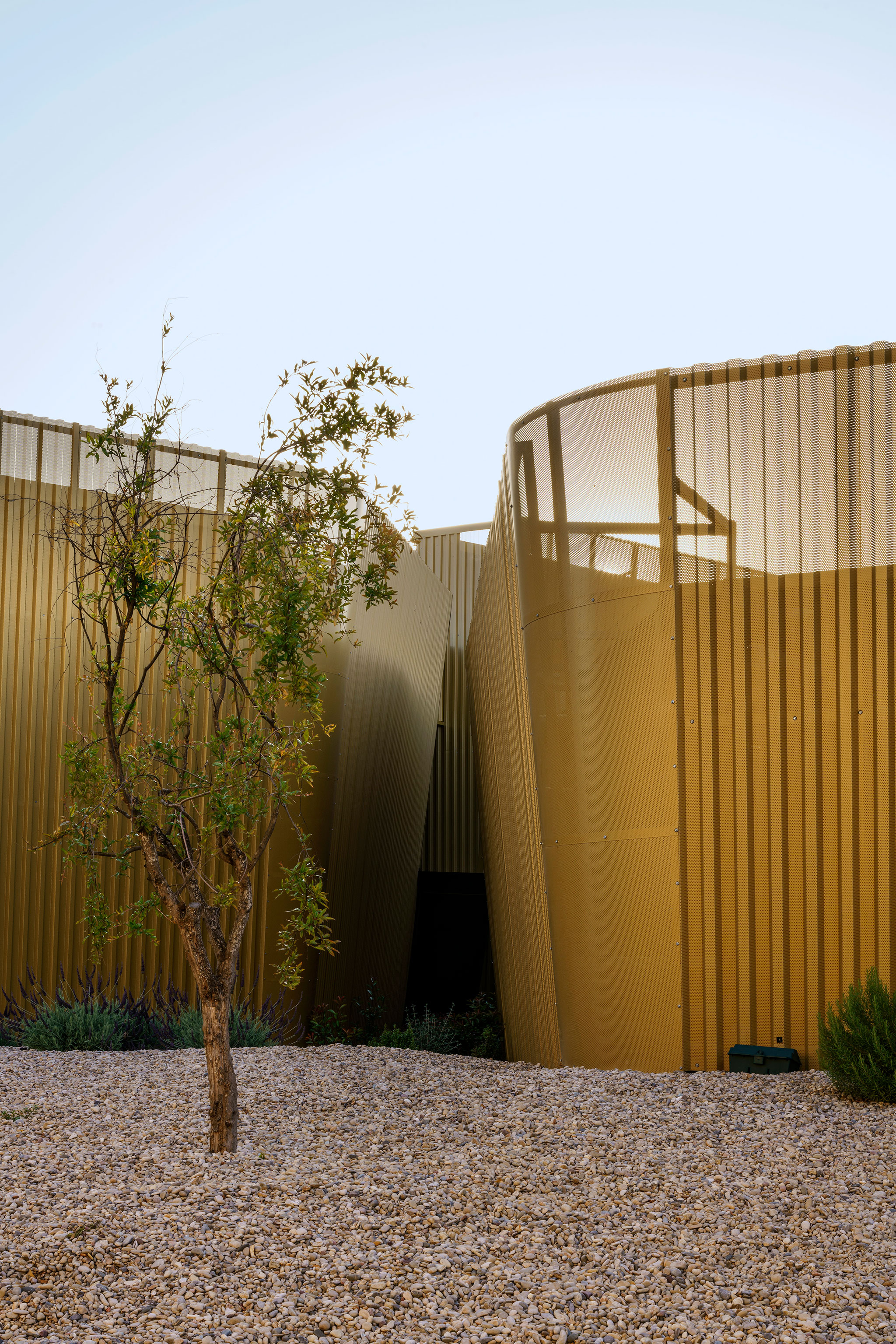
The project developed by Mollinedo Arquitectura separates the public and private industrial circulations with two different entrances, establishing dialogues between the different volumes of the complex through turns, interstices and voids, which show a flexible and organic reflection for the relationship of the complex with the territory.
The exterior skin of the building made of corrugated microperforated sheet metal resembles the colour of olive oil, blending the complex with the tones present in the surrounding landscape. Through the open patios, gardens and type of paving used, the project connects the exterior and the interior, seeking to humanise the intervention and dialogue with the environment.

Almazara Acesur by Mollinedo Arquitectura. Photograph by Jesús Granada.
Project description by Mollinedo Arquitectura
The work is located in the municipality of Jabalquinto (Jaén). The plot where the work is being carried out is flanked by industrial facilities such as an olive mill to the east, an animal farm to the south, crop fields to the north and the Bailen-Motril motorway to the west. The plot is in a hollow and there are no external references where an idea or development of implementation can be based. The place usually gives clues to already written strategies, here the absence and freedom is so wide that it is tense.
Observing the nearby nature led us to reflect on how to intervene in this territory and integrate the olive mill and the olive oil tourism centre. We were concerned that the global intervention would become an act of disconnection with the environment, absence of mimetic reflection or a rigid intervention.
The idea was born from observing how the olives are positioned when they fall to the ground, some half-buried, others almost supported or dispersed, where what really defines their reading are their interstitial relationships, revealing their voids and volumetric games. The intervention is based on this organic dialogue. The geometry of the pieces that make up the whole of the oil mill is born from the shape of the fruit. After various sequences, the figure of the asymmetric hexagon is reached as a mechanism of integration and design. The pieces are related to each other through a reasoned randomness that optimizes their function.

Using this module, which is a call to nature and the concept of repetition, helps to understand the implantation. The pieces are positioned in a variable manner and with freedom in height, providing dynamism to the fit of the whole. The change in height is motivated by the use it houses. The pieces dialogue through their turns, interstices and voids, showing a flexible and organic reflection of implantation, as well as the delicate relationship with the territory. Landscaped mounds on the outer contour of the pieces simulate the semi-buried, enhancing the idea and transporting us to the hills of this land making the pieces belong to the field by extension.
The textured outer skin of the pieces is a color that resembles olive oil. This unitary colour provides integration and mimicry. The envelope made of corrugated microperforated sheet metal is separated by 60 cm from the enclosure to facilitate maintenance, insertion of machinery and sun protection. The skins are rotated and curved at the corners to provide an organic character.
The intervention has two entrances: a main public one and a private industrial one. At the main entrance we are greeted by a landscaped hexagonal square. The outline is executed with a breakwater that aims to isolate the visitor from the environment and connect them from the start with the building. In this square there are parking spaces for vehicles and buses. The first of the five pieces in the programme is the reception area, a landscaped patio, an area for the sale and display of oil, and a conference area. To the right is the winery made up of four modules that, by geometry, refer to the flower of the olive tree. Vertical light cracks appear at the meeting of each piece and connect us with the environment. To the left of the reception is the piece that contains offices, a laboratory, permanent staff, toilets and landscaped interior patios. The connection, from the reception room to the two mentioned, is in the interstices and is with covered walkways like black boxes, smaller in scale and transparent through which the relationships between rooms, turns and gardens can be appreciated.

The fourth room is for installations, storage, CT, workshop, boiler, temporary staff. It is an isolated room that is related to the offices due to its geometry and position, dialoguing through its turns and interstices. The fifth room is the oil mill itself, formed by a pit, patio and production area. It is an independent room that has movement in its surroundings, being embraced by the rest of the rooms mentioned.
Connecting the exterior and the interior is another of the objectives through open patios, gardens and the type of pavement used, humanizing this intervention.
The construction process has been based on sustainability and energy efficiency, recovering all the excavated land to formalize the mounds and topography, the excavated gravel for filling under slabs, creating water recovery cisterns for irrigation and cleaning, an area for photovoltaic panels, machinery with high and efficient COP, use of prefabricated concrete and steel. Native plants with low water consumption make up the landscaping.
Generating a new integrated and humanized landscape has been the ultimate goal of this project.














































